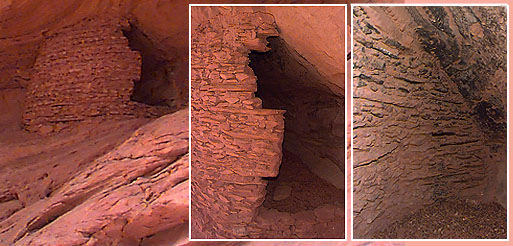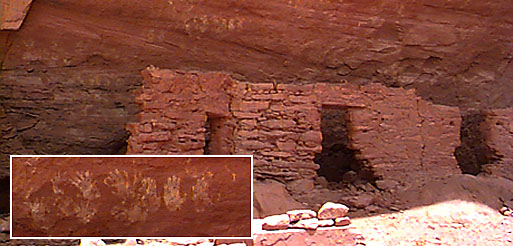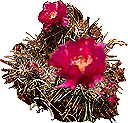
 The Cliff Dwellers |
|
A typical cliff dwelling of the Anasazi people was located high enough to protect the inhabitants from the periodic flooding that occurred in the canyon basin and was usually tucked under the southern end of a natural cave in the sandstone. This location made for shade during the summer months while it afforded sunlight and warmth in the winter. The insets show two pictographs (top left) that were found on the walls of the cave along with nearby petroglyphs of a spiral and crane. The pictographs suggest a translation which will be discussed later on. The petroglyphs are believed to be a clan symbol. To the far right are sets of pecked hands and feet, the longest of which was 11 inches, located on the floor outside the entrance to the dwelling. Here only small left hands are shown and the footprints appear to have been traced from moccasins.  Amazingly, most of the remote dwellings in the Mystery Canyon area are still intact. This dwelling even had evidence of grain and was blackened inside by years of smoking fires. The door would have been covered by either an animal skin or by some plant fibers. Not all of these dwellings were used as a residence - some were specifically designed for the storage of corn, squash and other agriculture resources.
The size of the dwellings raised some interesting questions. How tall were the occupants? Bill Crawley told me about some "mummies" that were found, and since reburied, who were adults of from three to three and a half feet tall. Apparently the "little hands" we were seeing were not all those of children. It is an interesting fact that many old world civilizations were shorter than today's average height. Nutrition is often quoted as the determining factor, but it seems hard to imagine such a dramatic physical change could occur within a hundred generations. We would welcome any comments or insight from our readers on this point.
 Anatomists say that the gender of the hand can easily be determined by measuring the index finger and the ring finger. In women, the index is longer than the other. This appears to be our observation as we look at the pictographs made by pressing pigment covered hands on the flat canyon wall.
Was this some ritual or celebration - or just a way to decorate the living space? We can only guess. |

 The stones used for the dwellings are abundantly available and would have required little foraging. Mortar, as we discovered on our boots, is readily available in the form of clay and mud, which rapidly hardens to the consistency of cement when allowed to bake under the hot sun.
The stones used for the dwellings are abundantly available and would have required little foraging. Mortar, as we discovered on our boots, is readily available in the form of clay and mud, which rapidly hardens to the consistency of cement when allowed to bake under the hot sun.